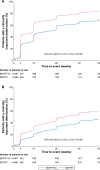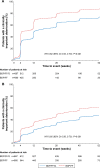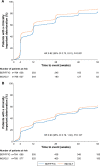Extrafine triple therapy delays COPD clinically important deterioration vs ICS/LABA, LAMA, or LABA/LAMA
- PMID: 30880943
- PMCID: PMC6400232
- DOI: 10.2147/COPD.S196383
Extrafine triple therapy delays COPD clinically important deterioration vs ICS/LABA, LAMA, or LABA/LAMA
Abstract
Background: Current pharmacological therapies for COPD improve quality of life and symptoms and reduce exacerbations. Given the progressive nature of COPD, it is arguably more important to understand whether the available therapies are able to delay clinical deterioration; the concept of "clinically important deterioration" (CID) has therefore been developed. We evaluated the efficacy of the single-inhaler triple combination beclometasone dipropionate, formoterol fumarate, and glycopyrronium (BDP/FF/G), using data from three large 1-year studies.
Methods: The studies compared BDP/FF/G to BDP/FF (TRILOGY), tiotropium (TRINITY), and indacaterol/glycopyrronium (IND/GLY; TRIBUTE). All studies recruited patients with symptomatic COPD, FEV1 <50%, and an exacerbation history. We measured the time to first CID and to sustained CID, an endpoint combining FEV1, St George's Respiratory Questionnaire (SGRQ), moderate-to-severe exacerbations, and death. The time to first CID was based on the first occurrence of any of the following: a decrease of ≥100 mL from baseline in FEV1, an increase of ≥4 units from baseline in SGRQ total score, the occurrence of a moderate/severe COPD exacerbation, or death. The time to sustained CID was defined as: a CID in FEV1 and/or SGRQ total score maintained at all subsequent visits, an exacerbation, or death.
Results: Extrafine BDP/FF/G significantly extended the time to first CID vs BDP/FF (HR 0.61, P<0.001), tiotropium (0.72, P<0.001), and IND/GLY (0.82, P<0.001), and significantly extended the time to sustained CID vs BDP/FF (HR 0.64, P<0.001) and tiotropium (0.80, P<0.001), with a numerical extension vs IND/GLY.
Conclusion: In patients with symptomatic COPD, FEV1 <50%, and an exacerbation history, extrafine BDP/FF/G delayed disease deterioration compared with BDP/FF, tiotropium, and IND/GLY.
Trial registration: The studies are registered in ClinicalTrials.gov: TRILOGY, NCT01917331; TRINITY, NCT01911364; TRIBUTE, NCT02579850.
Keywords: anticholinergics; beta-2 agonists; chronic obstructive pulmonary disease; disease activity; inhaled corticosteroids.
Conflict of interest statement
Disclosure DS is supported by the National Institute for Health Research (NIHR) Manchester Biomedical Research Centre (BRC). DS received personal fees from Chiesi during the conduct of these studies. Outside the submitted work, DS reports grants and personal fees from Almirall, AstraZeneca, Boehringer Ingelheim, Chiesi, GlaxoSmithKline, Glenmark, Johnson and Johnson, Merck, NAPP, Novartis, Pfizer, Takeda, Teva, Theravance, and Verona, and personal fees from Genentech and Skyepharma. LMF reports grants, personal fees, and non-financial support from Boehringer Ingelheim, Chiesi Farmaceutici, GlaxoSmithKline, Merck Sharp & Dohme, Takeda, AstraZeneca, Novartis, Menarini, Laboratori Guidotti, and Almirall; personal fees and non-financial support from Pearl Therapeutics, Mundipharma, and Boston Scientific; personal fees from Kyorin, Bayer, and Zambon; and grants from Pfizer, Dompè, Malesci, Alfasigma, and Vree Health Italia, all outside the submitted work. SV and SP are employed by Chiesi, the sponsor of the studies. AP reports grants, personal fees, non-financial support, and advisory board membership from Chiesi, AstraZeneca, GlaxoSmithKline, Boehringer Ingelheim, Mundipharma, and TEVA; personal fees and non-financial support from Menarini, Novartis, and Zambon; and grants from Sanofi, all outside the submitted work. The authors report no other conflicts of interest in this work.
Figures




Similar articles
-
Efficacy and safety of single-inhaler extrafine triple therapy versus inhaled corticosteroid plus long-acting beta2 agonist in eastern Asian patients with COPD: the TRIVERSYTI randomised controlled trial.Respir Res. 2021 Mar 23;22(1):90. doi: 10.1186/s12931-021-01683-2. Respir Res. 2021. PMID: 33757520 Free PMC article. Clinical Trial.
-
Extrafine inhaled triple therapy versus dual bronchodilator therapy in chronic obstructive pulmonary disease (TRIBUTE): a double-blind, parallel group, randomised controlled trial.Lancet. 2018 Mar 17;391(10125):1076-1084. doi: 10.1016/S0140-6736(18)30206-X. Epub 2018 Feb 9. Lancet. 2018. PMID: 29429593 Clinical Trial.
-
Triple therapy in COPD: new evidence with the extrafine fixed combination of beclomethasone dipropionate, formoterol fumarate, and glycopyrronium bromide.Int J Chron Obstruct Pulmon Dis. 2017 Oct 6;12:2917-2928. doi: 10.2147/COPD.S146822. eCollection 2017. Int J Chron Obstruct Pulmon Dis. 2017. PMID: 29062229 Free PMC article. Review.
-
Real-World Effectiveness of Triple Extrafine Fixed-Dose Combination with Beclomethasone/Formoterol/Glycopyrronium on Symptoms and Lung Function in COPD: A Systematic Review and Meta-Analysis.Int J Chron Obstruct Pulmon Dis. 2025 May 27;20:1723-1736. doi: 10.2147/COPD.S511334. eCollection 2025. Int J Chron Obstruct Pulmon Dis. 2025. PMID: 40453981 Free PMC article.
-
The TRIFLOW study: a randomised, cross-over study evaluating the effects of extrafine beclometasone/formoterol/glycopyrronium on gas trapping in COPD.Respir Res. 2020 Dec 9;21(1):323. doi: 10.1186/s12931-020-01589-5. Respir Res. 2020. PMID: 33298062 Free PMC article. Clinical Trial.
Cited by
-
Prognostic value of clinically important deterioration in COPD: IMPACT trial analysis.ERJ Open Res. 2021 Mar 8;7(1):00663-2020. doi: 10.1183/23120541.00663-2020. eCollection 2021 Jan. ERJ Open Res. 2021. PMID: 33718490 Free PMC article.
-
The Impact of 52-Week Single Inhaler Device Triple Therapy versus Dual Therapy on the Mortality of COPD Patients: A Systematic Review and Meta-Analysis of Randomized Controlled Trials.Life (Basel). 2022 Jan 25;12(2):173. doi: 10.3390/life12020173. Life (Basel). 2022. PMID: 35207460 Free PMC article. Review.
-
Day and Night Control of COPD and Role of Pharmacotherapy: A Review.Int J Chron Obstruct Pulmon Dis. 2020 Jun 4;15:1269-1285. doi: 10.2147/COPD.S240033. eCollection 2020. Int J Chron Obstruct Pulmon Dis. 2020. PMID: 32606638 Free PMC article. Review.
-
Prompt initiation of triple therapy following hospitalization for a chronic obstructive pulmonary disease exacerbation in the United States: An analysis of the PRIMUS study.J Manag Care Spec Pharm. 2022 Dec;28(12):1366-1377. doi: 10.18553/jmcp.2022.28.12.1366. J Manag Care Spec Pharm. 2022. PMID: 36427341 Free PMC article.
-
PRIMUS - Prompt Initiation of Maintenance Therapy in the US: A Real-World Analysis of Clinical and Economic Outcomes Among Patients Initiating Triple Therapy Following a COPD Exacerbation.Int J Chron Obstruct Pulmon Dis. 2022 Feb 10;17:329-342. doi: 10.2147/COPD.S347735. eCollection 2022. Int J Chron Obstruct Pulmon Dis. 2022. PMID: 35177901 Free PMC article.
References
MeSH terms
Substances
Associated data
LinkOut - more resources
Full Text Sources
Medical

